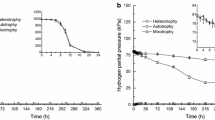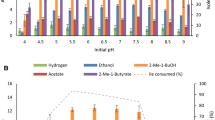Abstract
Coprothermobacter platensis is an anaerobic, proteolytic, thermophilic bacterium, which is phylogenetically related to the genera Fervidobacterium and Thermotoga. The organism was found to reduce thiosulfate to sulfide during growth on carbohydrates and proteinaceous substrates. Growth on glucose was inhibited by hydrogen, but this inhibition was overcome by thiosulfate reduction, stirring, increasing the headspace volume and coculturing with a hydrogen-consuming methanogen. Alanine was detected during glucose fermentation, its formation was influenced by the hydrogen concentration in the gas phase suggesting an electron sink mechanism, as was previously reported for the phylogenetically related Thermotogales and the archaeal hyperthermophile Pyrococcus furiosus.
Similar content being viewed by others
References
Etchebehere C, Pavan ME, Zorzópulus J, Soubes M & Muxí L (1998) Coprothermobacter platensis sp. nov., a new anaerobic proteolytic thermophilic bacterium isolated from an anaerobic mesophilic sludge</del>. Int. J. Sys. Bacteriol. 48: 1297–1304.
Fardeau ML, Cayol JL, Magot M & Ollivier B (1993) H2 oxidation in the presence of thiosulfate, by a Thermoanaerobacter strain isolated form an oil-producing well. FEMS Microbiol. Lett. 113: 327–332.
Fardeau ML, Faudon C, Cayol JL, Magot M, Patel BK & Ollivier B (1996) Effect of thiosulphate as electron acceptor on glucose and xylose oxidation by Thermoanaerobacter finnii and a Thermoanaerobacter sp. isolated from oil field water. Res. Microbiol. 147: 159–65.
Jeanthon C, Reysenbach AL, LïHaridon S, Gambacorta A, Pace NR, Glénat P & Prieur D (1995) Thermotoga subterranea sp.nov., a new thermophilic bacterium isolated from a continental oil reservoir. Arch. Microbiol. 164: 91–97.
Kengen SWM & Stams AJM (1994) Formation of L-alanine as a reduced end product in carbohydrate fermentation by the hyperthermophilic archaeon Pyrococcus furiosus. Arch. Microbiol. 161: 168–175.
Lamed RJ, Lobos JH & Su TM (1988) Effects of stirring and hydrogen on fermentation products of Clostridium thermocellum. Appl. Environ. Microbiol. 54: 1216–1221.
Lien T, Madsen M, Rainey FA & Birkeland NK (1998) Petrotoga mobilis sp. nov., from a North Sea oil-production well. Int. J. Sys. Bacteriol. 48: 1007–1013.
Lowe SE, Jain MK & Zeikus JG (1993) Biology, ecology and biotechnological applications of anaerobic bacteria adapted to environmental stresses in temperatures, pH, salinity, or substrates. Microbiol. Rev. 57: 451–509.
Muxí L, Zunino L, Tarlera S & Soubes M (1992) Characterization of a methanogenic sludge to be used as inoculum for a high-rate reactor. World J. Microbiol. Biotechnol. 8: 632–634.
Örlygsson J, Anderson R & Svensson BH (1995) Alanine as an end product during fermentation of monosaccharides by Clostridium strain P2. Antonie van Leeuwenhoek 68: 273–280.
Rand MC, Greenberg AE & Taras MJ (1975) Sulfide, methylene blue method. In: Standard Methods for the Examination ofWater and Wastewater. APHA, AWWA, WPCE 14 edn.
Ravot G, Ollivier B, MagotM, Patel BKC, Crolet JL, Fardeau ML & García JL (1995) Thiosulfate reduction, an important physiological feature shared by members of the Order Thermotogales. Appl. Environ. Microbiol. 61: 2053–2055.
Ravot G, Ollivier B, Fardeau ML, Patel BKC, Andrews KT, Magot M & García JL (1996) L-alanine production from glucose fermentation by hyperthermophilic members of the Domains Bacteria and Archaea: a remnant of an ancestral metabolism? Appl. Environ. Microbiol. 62: 2657–2659.
Selig M, Xavier KB, Santos H & Schönheit P (1997) Comparative analysis of Embden-Meyerhof and Entner-Doudoroff glycolytic pathways in hyperthermophilic archaea and the bacterium Thermotoga. Arch. Microbiol. 167: 217–232.
Smibert RM & Krieg NR (1994) Phenotypic characterization. In: Gerhardt P, Murray RGE, Wood WA & Krieg NR (Eds) Methods for General and Molecular Bacteriology. American Society for Microbiology, Washington D.C.
Touzel JP & Albagnac G (1983) Isolation and characterization of Methanococcus mazeii strain MC3. FEMS Microbiol. Lett. 16: 241–245.
Wiegel J & Ljungdahl G (1981) Thermoanaerobacter ethanolicus gen. nov., sp. nov., a new extreme thermophilic, anaerobic bacterium. Arch. Microbiol. 128: 343–348.
Author information
Authors and Affiliations
Corresponding author
Rights and permissions
About this article
Cite this article
Etchebehere, C., Muxí, L. Thiosulfate reduction and alanine production in glucose fermentation by members of the genus Coprothermobacter. Antonie Van Leeuwenhoek 77, 321–327 (2000). https://doi.org/10.1023/A:1002636212991
Issue Date:
DOI: https://doi.org/10.1023/A:1002636212991




